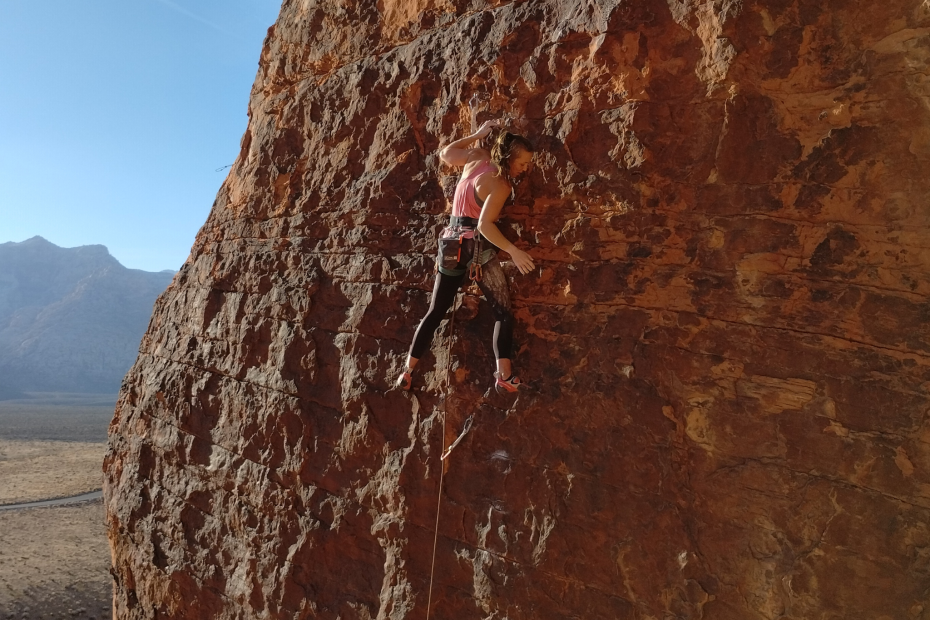We all have things we’re good at – and things that we’re, um, less good at. And doing things we’re good at is way more fun than doing things we’re bad at. But I’m here to argue that you should do what you’re bad at if you want to become a better climber.
How did we get weaknesses in the first place?
In climbing, your strengths and weaknesses are largely influenced by two things: your anatomy, and your surroundings. Your height, flexibility, and the size of your hands are anatomical things that’ll partially dictate what comes naturally to you. There’s a reason why small, light women excel at crimping and big, muscular men can throw down on slopers.
And the kind of climbing around you – as well as the people you climb with – will partially dictate what you practice the most. If you live close to the Red River Gorge, you’ll probably spend more time on gymnastic, pumpy sport climbs. But if you live close to Joshua Tree, you’ll likely do more technical bouldering on tiny holds. And if your crew really likes a certain style and avoids others, guess what: you’ll probably end up doing the same.
These things are just reality – and that’s okay. But just because you’re somewhat predisposed to being better at some things than others, doesn’t mean you can’t get really fucking good at everything. You just have to be intentional about it.

Why not just climb things that suit you?
First, let me just say that you can totally do that. If you want to excel in one thing and be kind of shmeh in others, that’s cool. You do you. But if you’re reading this, chances are you want to get better. And just like everything else in life, the path to getting better is focusing on the things you can’t do well (yet).
If you’re a route climber, I think it’s even more important to be well-rounded. Why? Because routes are more varied. If you eliminate routes that have sections of [insert the style you’re bad at here], you’ll be seriously limited in what you can try. Let’s say a route has a slopey section and a crimpy section. Let’s say the crimps are the crux – but you need to climb the slopers to get there. If you’re really good at crimps, but really bad at slopers, the slopey section will probably be too exhausting for you to have any chance of sending: you’ll be too gassed by the time you get to it.
But if you worked on your weaknesses, and got better at slopers, that route might become sendable. It might even become easy: you’re still good at crimps, right? So if you become average at slopers, you’d crush that thing. See where I’m going with this? Having big weaknesses in your climbing is really limiting if you’re a route climber. This is true in bouldering too, but less so. Boulders are shorter, and often heavy in one style – so it’s easier to pick things that suit you (though I would still argue that it’s worth working on your weaknesses to become a better climber overall).
A case study of me
My best style is slab/vert, my antistyle is overhanging crimps (like a Moonboard), and I’m okay at roof climbing. I did a route at the New River Gorge this year with a slab crux. But you had to pull a roof to get to the crux (4 bolts of climbing) and get through some long, slightly overhanging crimp pulls to make it to the chains (3 bolts of climbing). The crux was pretty easy for me. But without being able to do some of the things I’m not naturally good at, I wouldn’t have stood a chance.
How to work on your weaknesses
First and foremost: learn to love failing. Honestly. I know this is easier said than done, but if you can reframe getting shut down from “I suck at this and therefore I’m bad at climbing” to “I’m getting better at climbing in this very moment”, it’ll be much easier to work your weaknesses on the regular. Don’t let failing at something you’re not good at (yet) influence your opinion of yourself as a climber. Climbing things you’re good at feels good in the short term (who doesn’t like sending?!), but climbing things you’re bad at will serve you in the long run.
Next time you go to the gym, or the crag, get on that climb that looks like it’ll be hard for you. Fall on crimps. Fall on roofs. Fall on slab. Embrace the suck.
Don’t forget about your strengths
A cautionary word: do climb things that you’re good at too. If you’re anything like me, you might find you have a high tolerance for failure and suffering (or maybe I’m just weird). I could work on my weaknesses every single session – and I used to. But everybody needs a win sometimes, and there’s benefit in clipping chains and topping boulders too. Climbing is supposed to be fun, after all. So climb some stuff you’re good at too – just not, like, all the time.
Featured image credit: Mark Patterson
